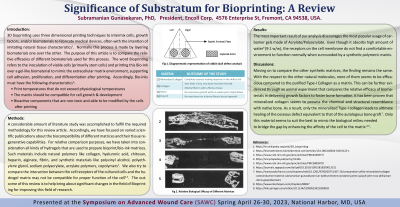Laboratory Research
(LR-016) Significance of Substratum for Bioprinting: A Review
Friday, April 28, 2023
7:15 PM - 8:30 PM East Coast USA Time

Introduction: 3D bioprinting uses three dimensional printing techniques to intermix cells, growth factors, and/or biomaterials to fabricate medical devices, often with the intention of imitating natural tissue characteristics1. Normally this process is made by layering biomaterials one over the other. The purpose of this article is to compare the relative efficacies of different biomaterials used for this process. The word Bioprinting refers to the inoculation of viable cells (primarily stem cells) and printing this Bio-Ink over a gel-like biomaterial to mimic the extracellular matrix environment, supporting cell adhesion, proliferation, and differentiation after printing. Accordingly, Bio-inks must have the following characteristics2:
Methods: A considerable amount of literature study was accomplished to fulfill the required methodology for this review article. Accordingly, we have focused on varied scientific publications about the biocompatibility of different matrices and their tissue regenerative capabilities. For relative comparison purposes, we have taken into consideration all kinds of hydrogels that are used to prepare bioprint/bio-ink matrices. Such materials include natural polymers like collagen, hyaluronic acid, chitosan, heparin, alginate, fibrin, and synthetic materials like polyvinyl alcohol, polyethylene glycol, sodium polyacrylate, acrylate polymers, copolymers3. We also try to compare the interaction between the cell receptors of the cultured cells and the hydrogel matrix may not be compatible for proper function of the cell4,5. The outcome of this review is to help bring about significant changes in the field of Bioprinting for improving this field of research.
Results: The most important result of our analysis discourages the most popular usage of carbomer gels made of Acrylate/Polyacrylate. Even though it absorbs high amount of water6 (9:1 w/w), the receptors on the cell membrane do not find a comfortable environment to function normally when surrounded by a synthetic polymeric matrix.
Discussion: Moving on to compare the other synthetic matrices, the finding remains the same. With the respect to the other natural molecules, none of them seems to be efficacious compared to the purified Type-I Collagen as a matrix. Only this material seems to suit the best to mimic the biological milieu needed to bridge the gap by enhancing the affinity of the cell to the matrix7,8.
- Print temperatures that do not exceed physiological temperatures
- The matrix should be compatible for cell growth & development
- Bioactive components that are non-toxic and able to be modified by the cells after printing
Methods: A considerable amount of literature study was accomplished to fulfill the required methodology for this review article. Accordingly, we have focused on varied scientific publications about the biocompatibility of different matrices and their tissue regenerative capabilities. For relative comparison purposes, we have taken into consideration all kinds of hydrogels that are used to prepare bioprint/bio-ink matrices. Such materials include natural polymers like collagen, hyaluronic acid, chitosan, heparin, alginate, fibrin, and synthetic materials like polyvinyl alcohol, polyethylene glycol, sodium polyacrylate, acrylate polymers, copolymers3. We also try to compare the interaction between the cell receptors of the cultured cells and the hydrogel matrix may not be compatible for proper function of the cell4,5. The outcome of this review is to help bring about significant changes in the field of Bioprinting for improving this field of research.
Results: The most important result of our analysis discourages the most popular usage of carbomer gels made of Acrylate/Polyacrylate. Even though it absorbs high amount of water6 (9:1 w/w), the receptors on the cell membrane do not find a comfortable environment to function normally when surrounded by a synthetic polymeric matrix.
Discussion: Moving on to compare the other synthetic matrices, the finding remains the same. With the respect to the other natural molecules, none of them seems to be efficacious compared to the purified Type-I Collagen as a matrix. Only this material seems to suit the best to mimic the biological milieu needed to bridge the gap by enhancing the affinity of the cell to the matrix7,8.

.png)